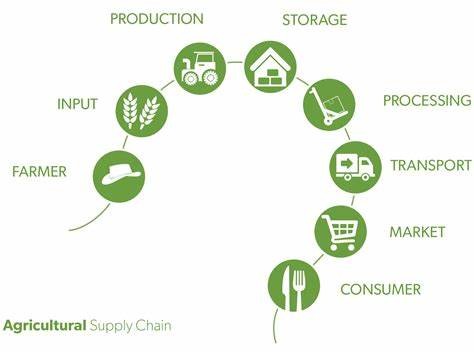In September of 1999, I found myself selling bananas at Istanbul’s Bayrampaşa Hali, Turkey’s largest fruit & vegetable market. It wasn’t the glamorous assignment I expected when I signed up for Dole’s largest fruit distributor in the region. Nor were the office hours entirely what I anticipated as I schemed to raid the corporate world a couple of months earlier at university. This here was a ghastly 8-hour shift that started at 4 AM every morning. The autumn rains, noisy diesel trucks and seasoned hagglers conspired to make my days downright intimidating. But I had to be there. It was important that I “learnt the psychology of the customer”, I was told. Specifically, that one customer that would show up first at 3:59 AM and virtually lock the going rates and influence stock sales for the rest of that day. It wasn’t cutting edge, but figuring out this early bird was at the heart of our Sales & Operations Plan, the epicentre of our supply chain operation.
Back then, the term digital barely applied beyond the realm of Casio watches and Pentium desktops. So it was not unusual that the technology supporting our supply chain infrastructure was limited to ethylene fruit-ripening gas (superior to charcoal, hurrah!!), a trusted thermostat and the proverbial psychologist’s chair. Supply was dictated to a large extent by external macro-events, such as the US-EU banana wars of the 90s, the El Niño climate phenomenon in the Pacific and the frequency of reefer vessels calling the Ecuadorian port of Guayaquil. Demand was largely planned around an empirical reading of our competitors’ stock levels and the school calendar year. And prices were set by a hypnotized quasi-nocturnal gent with a knack for distinguishing among 50 shades of green in the dark (well, 7 actually according to the Banana Colour Guide). Back then, there was nothing digital about pricing or matching supply & demand, let alone about managing a supply chain.
Much has changed since 1999 though. The world has gone digital and businesses that haven’t received the memo are at best lagging behind their peers, at worst out of business. In fact, research conducted by MIT and Capgemini shows companies failing to transform digitally have on average posted 24% lower profitability compared with their peers (across industries). Interesting. But what then does it mean to transform digitally, and what does that entail for supply chains? Transforming digitally, or digital transformation as it has come to be known, is a journey that necessitates intensive investments in technology and is governed by a centralized transformation management office. For practical purposes, we shall park the tale of the transformation management office for another day. The remainder of this essay shall be limited to discussing technological investments, specifically as they relate to supply chain planning and execution.
Planning
Digital transformation does not mean saying good night to Mr I-See-Green-in-the-Dark and his pre-dawn raids. Customer psychology remains valid. As do El Niños. Rather, such old school parameters will now need to be supplemented with real time intelligence if a supply chain is to remain competitive. This is achievable through sound investments in big data analytics software and machine learning.
-
Big data analytics: Organizations have always been exposed to troves of supply chain data. What they lacked, until recently, was the means by which to mine that data using complex algorithms and robust data processors. Billions of data points from invoices, loyalty cards, surveys, social network profiles and other digital data sources can now be crunched using advanced analytics tools to guide decision-making on pricing (increase revenues) and stock management (reduce costs). Making smart use of this big data would have liberated me from the noose of my early bird banana customer by providing me with more ammunition to influence the results of the crucial first negotiation session of the trading day.
- Machine learning: Machine learning is a form of Artificial Intelligence that goes beyond binary “if-then” rules. A computer machine is essentially taught to recognize laws governing patterns, then learnsto replicate those laws to big and disparate data sets. Leading supply chain playmakers are now integrating dozens of parameters to assist with matching supply and demand. When applied to bananas, for instances, such parameters may include everything from historical sales data and promotions to the seasonality of competing products such as strawberries and avocados
Execution
The requirements of today’s digitally-empowered customers have evolved in several ways. Same-day deliveries, real time updates and personalized services now take centre stage, requiring investments in cutting edge automated systems and geolocation technologies to ensure hasty deliveries. Examples include Automated Storage and Retrieval Systems (AS/RS), Automated Guided Vehicle Systems (AGVS) and Unmanned Aerial Vehicles (UAV).
-
AS/RS: Although nothing new, AS/RS technology is becoming increasingly important with the advent of the fussy digital customer. AS/RS technology enables the automated storage and retrieval of products at a warehouse, cutting lead times and improving accuracy.
-
AGVS: AGVS utilize geolocation and other technologies to automate the movement of products, typically at a warehouse or plant. Amazon claims its Kiva robots deliver a click-to-ship time of less than 15 minutes at its massive fulfilment centres, through which close to 500 million Stock Keeping Units (SKUs) are moved.
-
UAV: The technology is here, and it has been piloted (pardon the pun) by organizations as far and wide as Emirates Identity Authority in the UAE and Domino’s Pizza in New Zealand. The only thing keeping UAVs, such as delivery drones, grounded is the absence of regulatory laws. The benefits UAVs potentially hold for supply chains are so unimaginably vast that one is compelled to question when, not if, the drones would be allowed to take to the skies.
It would be wonderful if the next generation of fresh recruits got to usher guided vehicles and drones from the comfort of their bean bags, rather than suffer the terrible inconveniences of some byzantine fruit bazar. But then again - and digitize all you want, “learning the psychology of the customer” is an indispensable part of business that is here to stay.
. -
https://www.ahmadghannoum.com/
 English
English 






